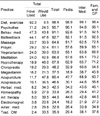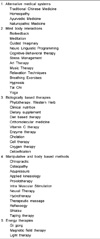Abstract
Complementary and alternative medicine (CAM) is a diagnosis, treatment and prevention which complements mainstream medicine by contributing to a common whole, satisfying a demand met by orthodox medicine. One of the most widely used classification structures, developed by National Center for Complementary and Alternative Medicine, divides CAM modalities into five categories: 1) Alternative medical systems, 2) Biologically based treatments, 3) Mind-body interventions, 4) Manipulative and body-based methods, 5) Energy therapies. But the effectiveness of the most CAM is not proven scientifically. The Federation of State Medical Boards developed model guidelines for the use of CAM in medical practice. The guidelines focus on encouraging the medical community to adopt consistent standards, ensuring the public health and safety by facilitating the proper and effective use of both conventional and CAM treatments. The integration of scientifically proven CAM into orthodox medicine is growing up and important in medicine. This kind of medicine is called "integrative medicine", which is a new paradigm in medicine.
Figures and Tables
References
1. World Health Organiation. Traditional and Alternative Medicine Facts and Figures. www.who.int/medicines/organiation/trm/factsheet271.doc.
2. IOM. Crossing the Quality Chasm: A New Health System for the 21st Century. 2001. Washington, DC: National Academy Press.
3. Ruggie M. Marginal to Mainstream: Alternative Medicine in America. 2004. Cambridge, United Kingdom: Cambridge University Press.
4. Berman BM, Singh BK, Lao L, Singh BB, Ferentz KS, Hartnoll SM. Physician's attitudes toward complementary or alternative medicine : A regional survey. J AM Board Fam Pract. 1995. 8:361–366.
5. NCCAM (National Center for Complementary and Alternative medicine). NIH Publication No 01-5001. Expanding Horizons of Healthcare : Five-Year Strategic Plan 2001-2005. 2000. Washington DC: U.S Department of Health and Human services.
6. Ernst E, Resch KL, Mills S, Hill R, Mitchell A, Willoughby M, White A. Complementary medicine : A definition. Br J Gen pract. 1995. 45:506.
7. Linde K, Clausius N, Ramirez G, Melchart D, Eitel F, Hedges LV, et al. Are the clinical effects of homeopathy placebo effect? A meta-analysis of placebo-controlled trials. Lancet. 1997. 350(9081):834–843.

8. Cucherat M, Haugh MC, Gooch M, Boissel JP. HMRAG. Homeopathic Medicines Research Advisory Group. Evidence of clinical efficacy of homeopathy. A meta-analysis of clinical trials. Eur J Clin Pharmacol. 2000. 56:27–33.
9. Lee SJ, et al. The way to go integrative medicine - complementary and alternative therapy. 2004. Ihan press;674–676.
10. Lee SJ, et al. Research for policy to integrate scientifically complementary and alternative therapy in conventional therapy. 2003. Korea Medical Association;77–89.
11. Complementary and Alternative Medicine(CAM) in Undergraduate Medicine Education(UME), Program Scan and Associated Deans UME Options, Faculty of Medicine University of Calgary. 2002. 05. 31.
12. Verhoef M, Brundin-Mather R, Jones A, Boon H, Epstein M. Complementary and alternative medicine in undergraduate medical education. Associate deans' perspectives. Can Fam Physician. 2004. 50:847–849. 853–855.
13. Curriculum in integrative medicine: A guide for Medical Educators, Consortium of Academic Health Centers for Integrative Medicine, Working Group on Education. 2004. 05.
14. Complementary, Alternative, Integrative Medicine Harvard Medical School Course #ME549.j. 2001. 01.
15. NCCAM 2002. What is Complementary and Alternative Medicine(CAM)? [online]. accessed June 10,2004. Available: http://nccam.nih.gov/health/whatiscam/index.htm.
16. Berndtson K. Complementary and alternative medicine. Integrative medicine : Business risks and opportunities. Physician Exec. 1998. 24:22–25.
17. Maizes V, Schneider C, Bell I, Weil A. Integrative medical education: Development and implementation of a comprehensive curriculum at the University of Arizona. Acad Med. 2002. 77:851–860.
18. M.D. Anderson Cancer Center. Place of Wellness. [Online]. 2004. accessed June 17,2004. Available: http://www.mdanderson.org/departments/wellness.




 PDF
PDF ePub
ePub Citation
Citation Print
Print





 XML Download
XML Download